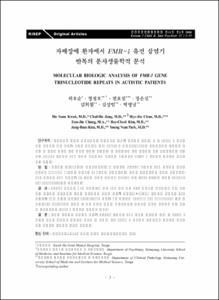자폐장애 환자에서 FMR-1 유전 삼염기 반복의 분자생물학적 분석
- Keimyung Author(s)
- Jung, Chul Ho; Kim, Hee Cheol; Kim, Jung Bum; Park, Young Nam; Chun, Hyo Jin
- Journal Title
- 소아청소년정신의학
- Issued Date
- 2000
- Volume
- 11
- Issue
- 1
- Abstract
- Objectives:There has been a rapid expansion of studies aimed at elucidating the genetic basis
of autistic disorder, especially it’s relationship to fragile-X syndrome. The detection of fragile X
chromosome(Xq27.3) by cytogenetic analysis has revealed many difficulties in testing. Therefore, to
explore the relationship between autistic disorder and fragile X syndrome, this study administered
molecular biologic methods which examined an unstable CGG repeat within the fragile X mental
retardation-1(FMR-1) gene.
Methods:Ninety nine autistic children and eight normal control children were tested. The number
of CGG repeats within FMR-1 gene was measured after amplification by PCR, and cytogenetic
analysis was also carried out to detect fragile site Xq27.3. Southern blot hybridization, using StB12.3
and/or Pfxa3 probe, was done for the patients showing expansion of more than 50 CGG repeats
(premutation).
Results:All but two autistic patients had no expansion in CGG repeats by PCR and there was no
significant statistical difference in number of CGG repeat in comparison with normal control. Two
autistic patients, considered as premutation by PCR analysis, had no full mutation or premutation by
Southern blot hybridization. All autistic children tested did not have any abnormal karyotype or
fragile site Xq27.3.
Conclusions:These results suggest that autistic patients may not have abnormality in FMR-1 gene
or abnormal expansion in CGG repeat. In conclusion, fragile X syndrome may not be antecedent of
autistic disorder.
연구목적:자폐장애의 원인을 유전학적으로 규명하려는 연구가 시도되고 있으며, 그 중 fragile X 증후군
과의 연관성에 대한 연구가 활발히 진행되고 있다. Fragile X 염색체(Xq27.3)는 세포유전학적 방법으로 증
명할 수 있으나 검사에 많은 제약과 단점이 있으므로, 본 연구에서는 보다 신뢰성이 높은 분자생물학적 방법
으로 FMR-1 유전자내 CGG 삼염기 반복부위를 분석하여 자폐장애와 fragile X 증후군의 연관성을 규명하
고자 하였다.
방 법:자폐장애 환아(99명)와 정상대조군(8명)을 대상으로 FMR-1 유전자의 CGG 반복배열 부위를
sense와 antisense primer를 이용하여 PCR법으로 분석하였으며, 동시에 세포유전학적 검사도 시행하였다.
PCR 분석에서 CGG 반복수가 50 이상인 경우에 대해서는 StB12.3 혹은 Pfxa3 probe를 이용한 Southern
blot hybridization으로 확인하였다.
결 과:FMR-1 유전자의 CGG 반복배열에 대한 PCR 분석 결과 CGG 삼염기의 반복배열의 수는 자폐
장애 환자군과 정상대조군 사이에 통계적으로 유의한 차이가 없었다(p=0.207). 자폐장애 환자에서 CGG
반복수가 50회 이상인 조기변이(premutation) 환자가 2명 있었으나 Southern blot hybridization 결과 완
전변이(full mutation)로 판정할 수 있는 경우는 없었다. 세포유전학적 검사에서 환자군 모두에서 정상 핵형
을 나타내었으며 fragile X 염색체는 확인되지 않았다.
결 론:이상의 결과에서 자폐장애 환자가 FMR-1 유전자의 CGG 삼염기 반복부위 이상, 즉 fragile X
염색체 이상을 동반하지 않았음을 증명할 수 있었다. 이는 fragile X 증후군을 자폐장애의 직접적인 원인이
라고 보기에는 어려움이 있음을 시사한다.
- Alternative Title
- MOLECULAR BIOLOGIC ANALYSIS OF FMR-1 GENE TRINUCLEOTIDE REPEATS IN AUTISTIC PATIENTS
- Publisher
- School of Medicine
- Citation
- 곽호순 et al. (2000). 자폐장애 환자에서 FMR-1 유전 삼염기 반복의 분자생물학적 분석. 소아청소년정신의학, 11(1), 3–15.
- Type
- Article
- ISSN
- 1225-729X
- 파일 목록
-
-
Download
 oak-bbb-4619.pdf
기타 데이터 / 1.97 MB / Adobe PDF
oak-bbb-4619.pdf
기타 데이터 / 1.97 MB / Adobe PDF
-
Items in Repository are protected by copyright, with all rights reserved, unless otherwise indicated.